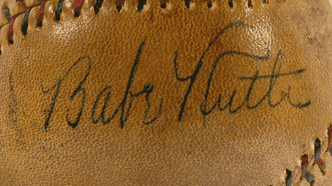With the 2024 MLB All-Star Game on Tuesday night, now is as good a time as any to revisit the most important piece of All-Star memorabilia ever sold: The first All-Star Game home run, hit by none other than Babe Ruth.
The 1933 All-Star Game was the first time fans were treated to the Midsummer Classic, pitting the best players from the National League against those of the American League.
Held in Chicago in tandem with the World’s Fair, the event was billed as the “Game of the Century” with fans voting for the representatives from each league via ballots printed in dozens of newspapers across the country. Ruth received 100,000 votes.
Among the Hall of Famers on the roster were Ruth, Lou Gehrig, Lefty Grove, Paul Waner and Jimmie Foxx (just to name a few).
In front of a crowd of nearly 50,000 fans, Ruth hit a two-run home run in the bottom of the third inning, marking the first home run in the history of the All-Star Game.
Sitting in the right-field stands that day was a man named Earl Brown, alongside his future wife, Mae Swoverland. As Ruth’s blast reached their seats, Brown managed to lay a hand on the ball, stopping it in its trajectory and knocking it beneath his seat. He was quickly able to snag the ball amid a sea of fans. His hand would remain red for the rest of the afternoon due to all the jovial handshakes, according to a letter of provenance written by Mae.
A newspaper clipping saved by Brown from the time recounted the event: “Brown was forced to leap into the air to snag the ball and had a lusty battle on his hands with the other fans to retain possession but did so, and today rates this memento as one of his most treasured possessions."
The couple tried to have Ruth sign the ball after the game, but had no luck, as the Bambino had already returned to the locker room. The next time the Yankees returned to play the White Sox, they made sure to buy seats behind first base, close enough to the field to have the best chance of securing Ruth’s autograph.
The plan worked, and Ruth signed it on the spot.
Brown kept the ball in his possession for decades before passing it down to his grandson, who eventually consigned it in 2006. The ball sold for $805,000, the third-most paid for a ball behind only McGwire’s 70th home run ball, which sold for $3 million in 1999, and Aaron Judge’s 62nd home run ball, which fetched $1.5 million in 2022.
Will Stern is a reporter and editor for cllct.

